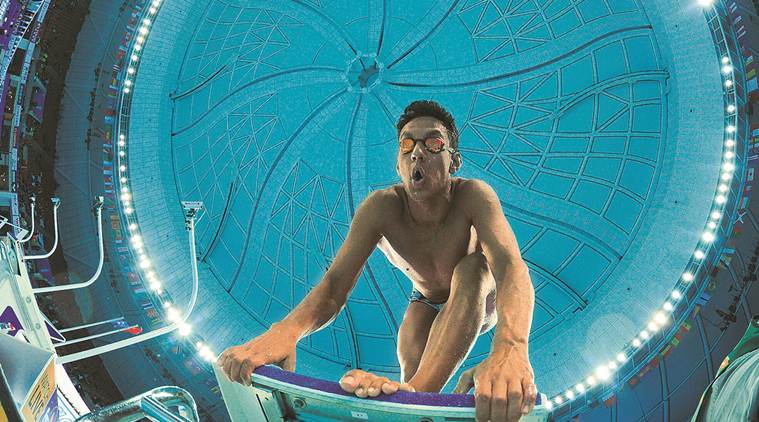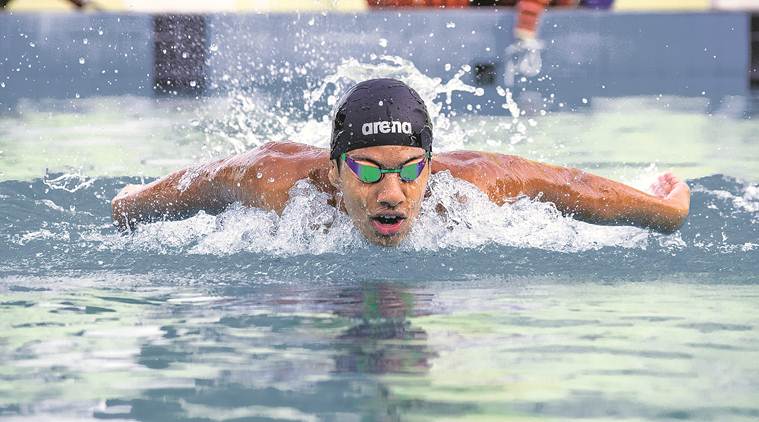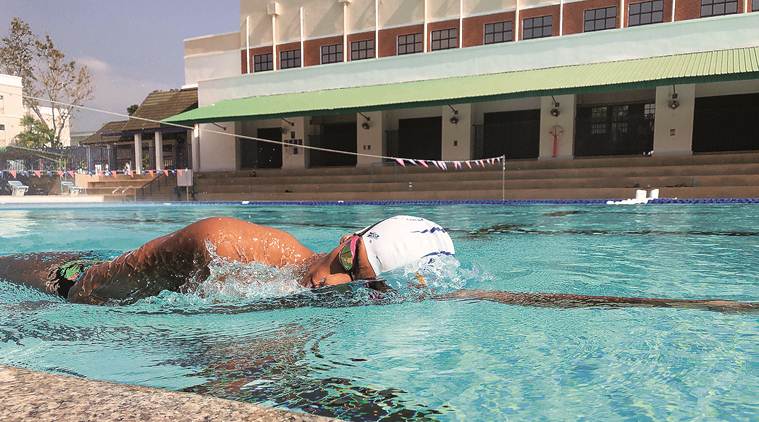
It takes 30 laps of an Olympic-size swimming pool (50 m) to complete a 1500m freestyle race. It’s a race that demands a carefully-measured blend of explosive pace and tireless swimming – one that a group of Indian teens have steadily been getting right.
Swimming has seen 12 national records erased in the last one year – across several events with Sajan Prakash and Srihari Natraj leading in the fly and backstroke. But over the 1500 free, at the senior nationals last September, five swimmers challenged the national record making it a hugely contested event. Together they’re pushing each other and have been targeting bigger goals – better showings at the World Championships and the 2020 Olympics. The ‘B’ Standard qualification mark for the Worlds – in Gwangju, South Korea this July – is 15:39.02 minutes, while the mark for Tokyo next year is 15:28.02.
As it stands, the Indian setup boasts three teenagers – Advait Page, Aryan Nehra and Aryan Makhija – that specialise in the 1500m event (there’s also Kushagra Rawat in the 800m). While Makhija (19) and Nehra (15) are training in the US and Thailand respectively, Page (18) has Florida University interested to rope him into their NCAA programme. While world standards are still out of reach for Indians with none ever making the ‘A’ mark, it is hoped that training at reputed facilities could yield results in an event where Asians fancy their chances the most – the 1500m and India hopes days of the ‘wild card’ are over.

ADVAIT PAGE: LEADER OF THE PACK
Best timing: 15:25.98 minutes (national record)
“Did the pain help you?”
Advait Page, 18 and wide-eyed, had been crossing 1500m Chinese swimming legend Sun Yang after the qualifying rounds at the Asian Games last August. That’s when the question was fired at him, after Sun recognised ‘that Indian swimmer.’ It was a distinct Australian goodly twang of celebrated coach Dennis Cotterell, who has shepherded Chinese swimming to global success. At an earlier meet where Page had spoken to the duo, the coach had told him pithily: “Training for 1500m free is like nothing else in swimming. Expect pain, and enjoy the pain.”
The Indian teen gobbled the advice and clocked 15:26 to come within the ‘B’ standard of the 1.5km swim for the Tokyo Olympics (15:28.02), well within the 15:39.14 he’s hoping to meet for qualification to the Worlds in July. Page will travel to Malaysia afterwards, attempting to inch closer to the ‘A’ mark – 15:07.38 – with the pain after training for the longest-course in a 50-pool a constant accompaniment as the coach had promised. Father Ashutosh Page, a former ONGC employee from Indore, is devoted to his son’s career, even as he continues to train in the ‘L’ shaped 50-pool (25m on each side of the right angle) at Shishukunj International School where he’s honed his stroke for the last few years.
“His mother, who works in a software firm, is now the main bread-winner of the family,” Ashutosh says, adding quietly that “the expenses to go train abroad earlier were not within our reach.” Joseph Schooling – Phelps’ conqueror from Rio – knows Page, and has advised the family to head to USA’s NCAA.
“Florida University has a very good long-distance programme (1500m) competing in Division 1, and they have shown interest in getting Advait there. Once he finishes his Class 12, we are looking at that as a good competitive route,” says the senior Page, even as the family frequently assembles to measure how much the boy has shot up — so critical in swimming with the wingspan.
India’s brightest talent over the 1500, was spotted early – a favourable twist of fate, given age-group competition doesn’t really factor in 400+ distances. He had followed elder sister Aditi into the pool at 8 years, and by 10, showed a proclivity towards longer events.
“I had good endurance event at 10, not so much the speed,” the teenager explains, with his father setting off to compile age-group American equivalent data from the US high-tech point system for a benchmark. “I’d compare his timings on the 800m to Americans who were 8, 9, 10 years. He was in the top 10 percent over the 800,” Ashutosh recalls.
Always showing promise, Page matured late in height. “Only after 17, I shot up, and now I’m 180cm (6 feet),” he says.
In 2018 he would cut his timing by almost 40 seconds, showing rapid progress as he gained in height. At the Asian age-group meet at Tashkent, he came down from 16:04 previously to be timed at 15:25 — the national record — training consistently only after his Class 11 exams before he headed out for the Jakarta Asiad. In a race where Sun Yang went under 15 for a 14:58.53 and was followed by the Asian country showing the fastest progress, Vietnam, with a couple of competitive Japanese, Page came 7th in the final at 15:29.96. The 1500m Asiad final was one of the stiffest. Page would also finish 8th over the 800m timed at 8:09.13.
Alongside Virdhawal Khade (50 free & fly), Srihari Natraj (backstroke), Sajan Prakash (fly) and Sandeep Sejwal (breaststroke), Page would enter the finals, though a medal would elude India. The 1500m had been an interesting development because at the last senior Nationals, about 5 swimmers had been in touching distance of the national record, with only 1 second separating the top-5.
Page, of course, leads the pack and is expected to slash seconds once he starts training abroad – hopefully at Florida. Receiving curious glances already at swim-meets, he intends to put his head down and heed the advice: Expect pain, enjoy pain.
ARYAN MAKHIJA: COUNTING YARDS, SWIMMING METRES
Best timing: 15:42 minutes
It’s not uncommon for Aryan Makhija to doze off during a lecture in college. He’s in the freshman year at the Auburn University in Alabama, United States, where his swimming exploits earned him a sports scholarship. The daily routine involves practice sessions that start at half-past-five in the morning, but it isn’t the lack of sleep that forces him to steal a few moments of shut-eye in class. It’s his event; the 1500m race – a gruelling test of both mind and body.
Ironically, it’s the grind itself that wakes him up as well.
“As a swimmer, you tend to twitch when you sleep,” he explains. “I get this heavy twitch and my desk is shaking. I wake up because of that and see the entire class is staring at me.”
The 19-year-old is a part of the new wave of Indian long distance swimmers that are clocking timings in the 1500m race that are steadily getting closer to the World Championships qualification mark. His current best is 15:42 min – just three seconds short of the required mark for the Worlds. And in the next fortnight, at a meet in Virginia, he’s hoping for that better timing.
“I feel I’ll be faster than I’ve ever been before,” he says. “There’s a huge amount of competition in the US, and that’s just going to help me improve. And I have.”
The Mumbai-teen has been in Auburn since December, and his immediate goals are to work on ‘some part of the strokes such as the kick.’ But it was the three years he spent training in South Africa, where he trained under South African national coach Graham Hill, that groomed him for the physical demands of the long distance race.
At that stage, he asserts going through a culture shock in terms of the training methods.
“There was a lot of intensity and more people to train with, more people to push me,” he recalls. “That just makes you step up your game automatically. And there was a whole lot of support in terms of physical strength training. In India, there was no gym work apart from just push-ups.”
It’s with that training that his timing improved by over 45 seconds from the 16:30 minute range he had been clocking three years ago.
Standing at six-feet, with an even longer wingspan, 6-foot-2, Makhija has known the sport ever since he was four. But it was only at the sub-junior nationals in 2012 that he figured out his forte lay in the longest distance.
“My club team in Mumbai had an event called the ‘marathon,’ which was 4000m. Somehow I started doing better in that than the older kids,” he says. “The longer race is gruelling physically but a lot relies on your mental strength. I somehow liked those races and that got me into the 1500m.”
His closest rival among Indians is national record holder Advait Page. Makhija is firm though that the pair shares a cordial relationship outside the pool, despite pushing each other during competitions.
“We both like soccer and support FC Barcelona, which is nice because too many rivalries aren’t that good,” he says. “So when the team wins, we celebrate together, and when they lose, we mourn. So it’s definitely a positive rivalry, but that being said, I wouldn’t want to be beaten.”
The biggest challenge Makhija has faced in college has been that the US follows ‘yards’ as opposed to ‘metres’ – the pool at the university is 25 yards, or 22.86 metres.
“There’s a lot of math I have to do before meets to get my tactics right,” he says.
As for the lectures, he prepares himself beforehand.
“If it’s a really important lecture, I tell myself before class to try and stay awake as much as possible, try and focus,” he says. Then adds, “or just keep the eyelids open.”

ARYAN NEHRA: THE JUNIOR WITH SENIOR WINS
Best timing: 15:38 minutes
Unlike on land where runners add to their mileage as they grow older, swimmers tend to peak at a younger age over long-distance events. So, 15-year-old Aryan Nehra, who made the ‘B’ qualification cut for the FINA Worlds in the 1500m at Malaysia last month, is in a hurry to shrug off the tag of the ‘prodigy.’
“There’s no time to revel as a junior ‘talent’ in the 1500m,” Nehra who hails from Rajkot-Ahmedabad (his father’s is a transferable job) and trains in Phuket, Thailand, says. Nehra came down from a modest 17:26 minutes two Marches ago in 2017 to clock 15:38.56 minutes last month, and sneak into the ‘B’ standard of 15:39.14 for the World Championships.
“The base for endurance is stronger in the teenage years in swimming, and it’ll be easier to be a sprinter at a later age. Yes, 2020 might be too soon to expect anything, but 2024 is my target and I definitely want to aim for the ‘A’ standard which we Indians haven’t really managed, before that,” the 6-footer, with a 6-foot-1 wingspan says.
That mark is 15:07.38 for the Worlds and a staggering 15:00.99 at the Tokyo Olympics – he will need to cut a whole 38 seconds for that in an event where China’s Sun Yang (14:31.02) burst out of his teens into record books.
Soviet Vladimir Salnikov went under 15:00 at the start of 1980s, and made it a benchmark for 1500-swimmers. For Nehra, the move to Phuket a little under two years ago, was hastened to precisely get moving towards that magical number, and not dawdle, before coming under the right programme.
Nehra, whose last kick over the final 300-400m was always his strength, is now working on his weakness to not fall out in the middle, as he trains at the Flying Fish Academy in Phuket, attached to the British International School which offered him a seat soon after he broke out at the Malaysian age-group meet in 2017 with 5 gold and 3 new meet records.
The youngest among the 1500m-lot (three years junior to Advait Page and four to namesake Aryan Makhija), was pulled out of school at home in Rajkot, after his father Vijay, a sports enthusiast who harboured IIT aspirations for his son like himself, reckoned that sport needed to be prioritised over academics.
“I’d been a sportsman – in volleyball, pole vault, but spread myself too thin and ended up being a master of none,” Vijay recalls, adding, “Once Aryan decided on swimming, after trying tennis and football, I knew I should let him pursue his dream and he can retrace steps in studies later.”
Plenty of research went into finding the Phuket facility – where Olympian Sajan Prakash had been on a FINA scholarship – and the decision was only made after Bangalore too was tried out, where the then 12-year-old Nehra watched the likes of Sandeep Sejwal and Virdhawal Khade train. (“He learnt a lot under Pradeep Kumar and had a good work rate, but we wanted the best program at that age-level,” says Vijay.)
Sincere in his reading habit and good at vocabulary and math, Nehra was suddenly liberated from the burden of Hindi, Sanskrit and Gujarati, his father says, and found a peer group for things that mattered – training long monotonous distances (daily seven km) for the 1500.
“Good peer group, great infrastructure and his commitment helped him though he always had a copybook stroke, arm and kick technique,” Vijay explains, of how the teenager built on his cardio-vascular endurance.
Aryan fell two days short of the Youth Olympics minimum age for the 2018 edition, and concentrated on training (when he earned the ‘B’ standard at the senior level) instead of travelling for easy medals and cash incentives at Khelo India.
“He’s aggressive and I’m practical about his goals. If training abroad was the best decision, I’m not going to change his mind,” says the father, a bureaucrat, who keeps an eagle’s eye on Aryan’s second 500m split – an area of improvement.
“Training here in Thailand is tailored for my body and it’s not just – ‘go swim this distance and come back.’ We do 20 repetitions of 200m, and every session is micro-focusses on how to get out, finish, pace the first 100, 200, 300, when to preserve energy, when to exert effort (power),” Aryan explains. Lactate thresholds, A1, A2, VO2 max are all monitored – all of which has helped him come get the 15:38 mark.
“Patience is the key, and I’ll slowly increase the load when I compete in Singapore (in two months’ time). Many Indian swimmers have gotten lost on the world stage because they over-trained and got hyper-excited. Through 1500 I’m learning patience and planning. The dream is to go close to 15:00,” he explains.
It’s the ‘A’ standard that he knew two years ago, was far too stiff a target for someone who felt land-locked in Ahmedabad. Then the Phuket sea beckoned.